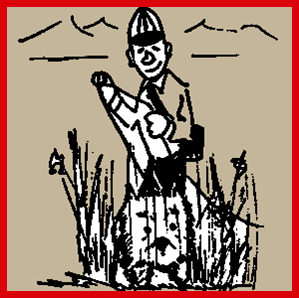
Enthusiastic Tracking
&
Rime Publications
To Contact Rime Publications:
Email: RimePubs@WestiesNW.com
Phone: 360-629-6434
Fax: 360-629-3537
33101 44th Avenue NW
Stanwood, WA 98292-7106
© Rime Publications 2011
It's a Team Sport Book Overview Table of Contents
Excerpted from Enthusiastic Tracking, the Step-by-Step Tracking Handbook by William R. Sanders. Copyright © 1998. Reprinted by permission. All rights reserved.
Introduction
Tracking is a fun activity for a dog and handler to enjoy together. The general idea is for the dog to follow the scent left by a person walking through an area and to find an article dropped by that person. It turns out dogs are quite good at this and naturally enjoy using their noses. We do not teach the dog how to use their noses; they are naturally thousands of times better at using their noses than we are at using our noses. We are going to teach the dog to stay with a track until he finds the article. We teach this by showing him that it is always lots of fun to do so!
The major premise behind the Enthusiastic Tracking training technique can be summarized by listing the three most important issues in successful dog tracking: motivation, motivation, and motivation. This analogy to the old real estate joke reminds us that no matter how well-trained our dog is he will only follow a scent (which we cannot smell ourselves), lead us down the track (which we cannot see ourselves), solve the scenting problems along the way (which we can at best only partially understand) and find the article at the end if he is strongly motivated to do so.
Tracking is unique in dog sport in that the dog knows what to do and the handler must read his dog and follow him. Although we carefully structure our initial training tracks so the handler does know exactly where the track is located, when the dog is tested, the dog must be prepared to assume the leadership role.
In addition to the supreme importance of motivation, the dog must master numerous scenting and problem solving skills before he will be successful. This training method provides ample opportunity for the dog to master these skills.
Tracking is a team sport in the truest sense of the concept. Although the dog is the master of scent and the team leader, the handler has a critical support role to play for the team to be successful. The first important aspect of this support role is for the handler to trust and believe his or her dog when the dog is committed to a track. The second aspect is when a scenting problem causes a dog to lose the track, the handler must organize the dog's search and encourage him to search nearby quadrants or areas that he has not yet covered.
This training method first develops basic scenting skills in the dog while building motivation to stay committed to the track. Then the method develops handler skills in reading the dog and organizing searches for lost tracks. Finally, the method refines the basic skills of the dog and handler until they are fully prepared to handle any situation they are likely to face in a test.
This book first describes training for the AKC Tracking Dog title and then it goes on to cover TDX training. The training is also suitable tor CKC's tracking program since both the Canadian titles are tested with tracks that are similar to be a little bit simpler than their AKC counterparts. AKC's variable surface tracking program is new and this method has not yet served as the basis for training dogs on to the VST title. So, no recommendation is made in that regard.
If you and your dog are well prepared, you and your dog will pass the TD test and you will have an excellent chance of passing the TDX test. You only get to pass once since most tracking tests are full. So, enjoy your training! It will account for 99% of your tracking experience. Make every training session fun for you and your dog. Focus on that fun and success in the goal of passing the tests will follow.
In this introduction, I discuss an overview of scent and how a dog works scent. The remaining chapters deal with a specific schedule of training activities that is designed to mold you and your dog into a confident tracking team.
Introduction
Phase 1. Intrudicing the Dog to Tracking
Phase 2. Developing Line tracking Skills.
Phase 3. Introduce Corners.
Phase 4. Multiple Corners.
Phase 5. Reading the Dog.
Phase 6. Track Age.
Phase 7. Perfecting Skills.
Phase 8. Preparing for the Test
Part II ̶ Advanced Tracking Toward the TDX Test
Phase A. Aging the Track to Three Hours.
Phase B. Cross tracks.
Phase C. Skill Improvement.
Phase D. Test-like Blind Tracks.
Phase E. Preparing for the Test.